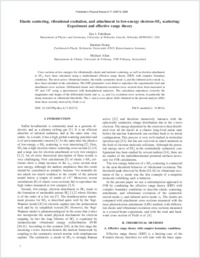Elastic scattering, vibrational excitation, and attachment in low-energy electron-SF₆ scattering: Experiment and effective range theory
- Fabrikant, Ilya I. Department of Physics and Astronomy, University of Nebraska, Lincoln, USA
- Hotop, Hartmut Fachbereich Physik, Technische Universität, Kaiserslautern, Germany
- Allan, Michael Department of Chemistry, University of Fribourg, Switzerland
-
18.02.2005
Published in:
- Physical Review A. - 2005, vol. 71, p. 022712-22721
English
Cross sections at low energies for vibrationally elastic and inelastic scattering, as well as electron attachment to SF₆, have been calculated using a multichannel effective range theory (ERT) with complex boundary conditions. The most active vibrational modes, the totally symmetric mode ν1 and the infrared active mode ν3, have been included in the calculation. The ERT parameters were fitted to reproduce the experimental total and attachment cross sections. Differential elastic and vibrational excitation cross sections have been measured at 30° and 135° using a spectrometer with hemispherical analyzers. The calculation reproduces correctly the magnitudes and shapes of the differential elastic and ν1, ν3, and 2ν1 excitation cross sections, in particular the sharp structures at vibrational thresholds. The s- and p-wave phase shifts obtained in the present analysis differ from those recently derived by Field et al. [Phys. Rev. A, 69, 052716 (2004)].
- Faculty
- Faculté des sciences et de médecine
- Department
- Département de Chimie
- Language
-
- English
- Classification
- Chemistry
- License
-
License undefined
- Identifiers
-
- RERO DOC 4494
- DOI 10.1103/PhysRevA.71.022712
- Persistent URL
- https://folia.unifr.ch/unifr/documents/299845
Statistics
Document views: 120
File downloads:
- Texte intégral: 351
